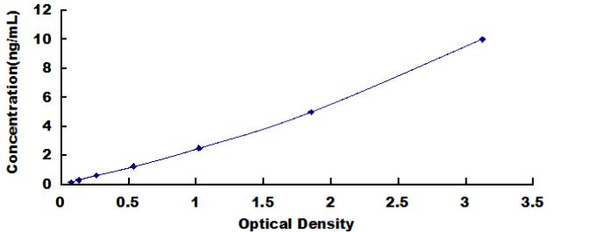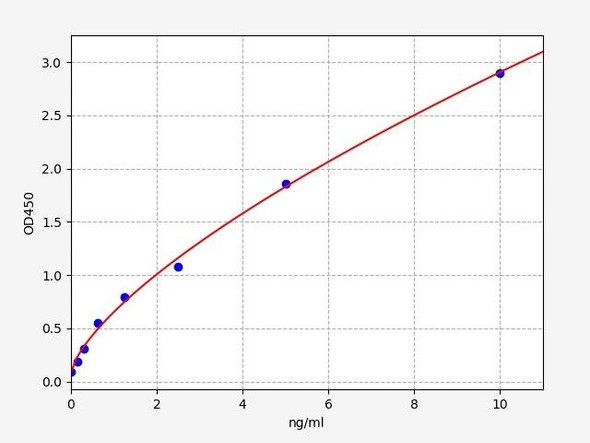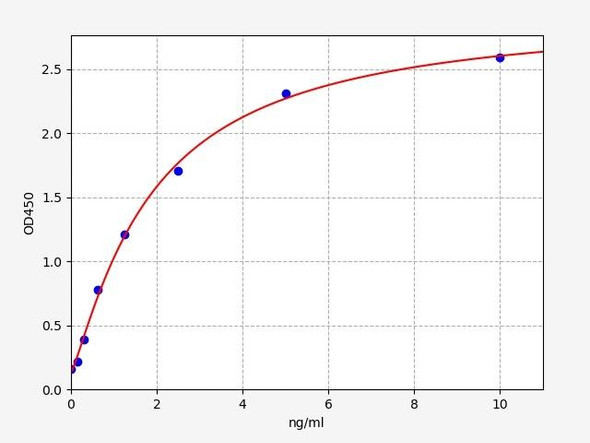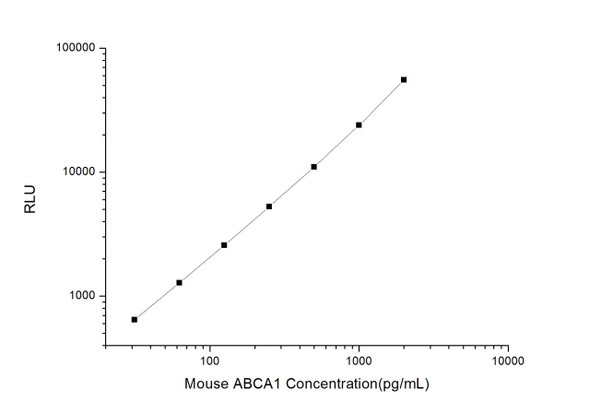Human Cell Biology ELISA Kits 3
Human ABCG1 (ATP Binding Cassette Transporter G1) CLIA Kit (HUES00370)
- SKU:
- HUES00370
- Product Type:
- ELISA Kit
- ELISA Type:
- CLIA Kit
- Size:
- 96 Assays
- Sensitivity:
- 18.75pg/mL
- Range:
- 31.25-2000pg/mL
- ELISA Type:
- Sandwich
- Reactivity:
- Human
- Sample Type:
- Serum, plasma and other biological fluids
- Research Area:
- Cell Biology
Description
| Assay type: | Sandwich |
| Format: | 96T |
| Assay time: | 4.5h |
| Reactivity: | Human |
| Detection method: | Chemiluminescence |
| Detection range: | 31.25-2000 pg/mL |
| Sensitivity: | 18.75 pg/mL |
| Sample volume: | 100µL |
| Sample type: | Serum, plasma and other biological fluids |
| Repeatability: | CV < 15% |
| Specificity: | This kit recognizes Human ABCG1 in samples. No significant cross-reactivity or interference between Human ABCG1 and analogues was observed. |
This kit uses Sandwich-CLIA as the method. The micro CLIA plate provided in this kit has been pre-coated with an antibody specific to Human ABCG1. Standards or samples are added to the appropriate micro CLIA plate wells and combined with the specific antibody. Then a biotinylated detection antibody specific for Human ABCG1 and Avidin-Horseradish Peroxidase (HRP) conjugate are added to each micro plate well successively and incubated. Free components are washed away. The substrate solution is added to each well. Only those wells that contain Human ABCG1, biotinylated detection antibody and Avidin-HRP conjugate will appear fluorescence. The Relative light unit (RLU) value is measured spectrophotometrically by the Chemiluminescence immunoassay analyzer. The RLU value is positively associated with the concentration of Human ABCG1. The concentration of Human ABCG1 in the samples can be calculated by comparing the RLU of the samples to the standard curve.
| UniProt Protein Function: | ABCG1: Transporter involved in macrophage lipid homeostasis. Is an active component of the macrophage lipid export complex. Could also be involved in intracellular lipid transport processes. The role in cellular lipid homeostasis may not be limited to macrophages. Belongs to the ABC transporter superfamily. ABCG family. Eye pigment precursor importer (TC 3. A. 1. 204) subfamily. 8 isoforms of the human protein are produced by alternative splicing. |
| UniProt Protein Details: | Protein type:Transporter, ABC family; Transporter; Membrane protein, multi-pass; Membrane protein, integral Chromosomal Location of Human Ortholog: 21q22. 3 Cellular Component: Golgi membrane; nucleoplasm; Golgi apparatus; endoplasmic reticulum membrane; recycling endosome; intracellular membrane-bound organelle; mitochondrion; integral to plasma membrane; plasma membrane; endosome; external side of plasma membrane Molecular Function:protein dimerization activity; protein binding; protein homodimerization activity; phospholipid transporter activity; protein heterodimerization activity; cholesterol transporter activity; toxin transporter activity; cholesterol binding; phospholipid binding; sterol-transporting ATPase activity; ADP binding; ATP binding Biological Process: cholesterol metabolic process; detection of hormone stimulus; response to high density lipoprotein stimulus; positive regulation of cholesterol biosynthetic process; intracellular cholesterol transport; cholesterol efflux; lipoprotein metabolic process; response to lipid; response to organic substance; amyloid precursor protein catabolic process; cholesterol homeostasis; reverse cholesterol transport; regulation of transcription, DNA-dependent; phospholipid efflux; transmembrane transport; phospholipid homeostasis |
| NCBI Summary: | The protein encoded by this gene is a member of the superfamily of ATP-binding cassette (ABC) transporters. ABC proteins transport various molecules across extra- and intra-cellular membranes. ABC genes are divided into seven distinct subfamilies (ABC1, MDR/TAP, MRP, ALD, OABP, GCN20, White). This protein is a member of the White subfamily. It is involved in macrophage cholesterol and phospholipids transport, and may regulate cellular lipid homeostasis in other cell types. Six alternative splice variants have been identified. [provided by RefSeq, Jul 2008] |
| UniProt Code: | P45844 |
| NCBI GenInfo Identifier: | 17433715 |
| NCBI Gene ID: | 9619 |
| NCBI Accession: | P45844. 3 |
| UniProt Secondary Accession: | P45844,Q86SU8, Q96L76, Q9BXK6, Q9BXK7, Q9BXK8, Q9BXK9 Q9BXL0, Q9BXL1, Q9BXL2, Q9BXL3, Q9BXL4, |
| UniProt Related Accession: | P45844 |
| Molecular Weight: | 86,628 Da |
| NCBI Full Name: | ATP-binding cassette sub-family G member 1 |
| NCBI Synonym Full Names: | ATP-binding cassette, sub-family G (WHITE), member 1 |
| NCBI Official Symbol: | ABCG1 |
| NCBI Official Synonym Symbols: | ABC8; WHITE1 |
| NCBI Protein Information: | ATP-binding cassette sub-family G member 1; ABC transporter 8; homolog of Drosophila white; ATP-binding cassette transporter 8; ATP-binding cassette transporter member 1 of subfamily G; white protein homolog (ATP-binding cassette transporter 8) |
| UniProt Protein Name: | ATP-binding cassette sub-family G member 1 |
| UniProt Synonym Protein Names: | ATP-binding cassette transporter 8; White protein homolog |
| Protein Family: | ABC transporter G family |
| UniProt Gene Name: | ABCG1 |
| UniProt Entry Name: | ABCG1_HUMAN |
As the RLU values of the standard curve may vary according to the conditions of the actual assay performance (e. g. operator, pipetting technique, washing technique or temperature effects), the operator should establish a standard curve for each test. Typical standard curve and data is provided below for reference only.
| Concentration (pg/mL) | RLU | Average | Corrected |
| 2000 | 54831 56611 | 55721 | 55693 |
| 1000 | 22665 25283 | 23974 | 23946 |
| 500 | 11970 10094 | 11032 | 11004 |
| 250 | 5091 5497 | 5294 | 5266 |
| 125 | 2806 2410 | 2608 | 2580 |
| 62.5 | 1405 1217 | 1311 | 1283 |
| 31.25 | 637 711 | 674 | 646 |
| 0 | 28 28 | 28 | -- |
Precision
Intra-assay Precision (Precision within an assay): 3 samples with low, mid range and high level Human ABCG1 were tested 20 times on one plate, respectively.
Inter-assay Precision (Precision between assays): 3 samples with low, mid range and high level Human ABCG1 were tested on 3 different plates, 20 replicates in each plate.
| Intra-assay Precision | Inter-assay Precision | |||||
| Sample | 1 | 2 | 3 | 1 | 2 | 3 |
| n | 20 | 20 | 20 | 20 | 20 | 20 |
| Mean (pg/mL) | 98.36 | 258.81 | 673.22 | 101.87 | 238.81 | 618.16 |
| Standard deviation | 8.56 | 25.91 | 50.76 | 12.47 | 27.10 | 43.46 |
| C V (%) | 8.70 | 10.01 | 7.54 | 12.24 | 11.35 | 7.03 |
Recovery
The recovery of Human ABCG1 spiked at three different levels in samples throughout the range of the assay was evaluated in various matrices.
| Sample Type | Range (%) | Average Recovery (%) |
| Serum (n=5) | 89-101 | 94 |
| EDTA plasma (n=5) | 87-101 | 93 |
| Cell culture media (n=5) | 85-98 | 90 |
Linearity
Samples were spiked with high concentrations of Human ABCG1 and diluted with Reference Standard & Sample Diluent to produce samples with values within the range of the assay.
| Serum (n=5) | EDTA plasma (n=5) | Cell culture media (n=5) | ||
| 1:2 | Range (%) | 89-104 | 93-108 | 89-105 |
| Average (%) | 96 | 99 | 96 | |
| 1:4 | Range (%) | 91-106 | 98-113 | 96-114 |
| Average (%) | 97 | 105 | 104 | |
| 1:8 | Range (%) | 98-114 | 89-100 | 86-101 |
| Average (%) | 104 | 94 | 93 | |
| 1:16 | Range (%) | 91-103 | 94-110 | 94-107 |
| Average (%) | 96 | 102 | 99 |
An unopened kit can be stored at 4°C for 1 month. If the kit is not used within 1 month, store the items separately according to the following conditions once the kit is received.
| Item | Specifications | Storage |
| Micro CLIA Plate(Dismountable) | 8 wells ×12 strips | -20°C, 6 months |
| Reference Standard | 2 vials | |
| Concentrated Biotinylated Detection Ab (100×) | 1 vial, 120 µL | |
| Concentrated HRP Conjugate (100×) | 1 vial, 120 µL | -20°C(shading light), 6 months |
| Reference Standard & Sample Diluent | 1 vial, 20 mL | 4°C, 6 months |
| Biotinylated Detection Ab Diluent | 1 vial, 14 mL | |
| HRP Conjugate Diluent | 1 vial, 14 mL | |
| Concentrated Wash Buffer (25×) | 1 vial, 30 mL | |
| Substrate Reagent A | 1 vial, 5 mL | 4°C (shading light) |
| Substrate Reagent B | 1 vial, 5 mL | 4°C (shading light) |
| Plate Sealer | 5 pieces | |
| Product Description | 1 copy | |
| Certificate of Analysis | 1 copy |
- Set standard, test sample and control (zero) wells on the pre-coated plate and record theirpositions. It is recommended to measure each standard and sample in duplicate. Note: addall solutions to the bottom of the plate wells while avoiding contact with the well walls. Ensuresolutions do not foam when adding to the wells.
- Aliquot 100µl of standard solutions into the standard wells.
- Add 100µl of Sample / Standard dilution buffer into the control (zero) well.
- Add 100µl of properly diluted sample (serum, plasma, tissue homogenates and otherbiological fluids. ) into test sample wells.
- Cover the plate with the sealer provided in the kit and incubate for 90 min at 37°C.
- Aspirate the liquid from each well, do not wash. Immediately add 100µL of BiotinylatedDetection Ab working solution to each well. Cover the plate with a plate seal and gently mix. Incubate for 1 hour at 37°C.
- Aspirate or decant the solution from the plate and add 350µL of wash buffer to each welland incubate for 1-2 minutes at room temperature. Aspirate the solution from each well andclap the plate on absorbent filter paper to dry. Repeat this process 3 times. Note: a microplatewasher can be used in this step and other wash steps.
- Add 100µL of HRP Conjugate working solution to each well. Cover with a plate seal andincubate for 30 min at 37°C.
- Aspirate or decant the solution from each well. Repeat the wash process for five times asconducted in step 7.
- Add 100µL of Substrate mixture solution to each well. Cover with a new plate seal andincubate for no more than 5 min at 37°C. Protect the plate from light.
- Determine the RLU value of each well immediately.






